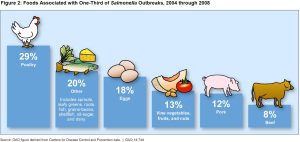Talking Turkey on Food Safety
- 48 million Americans (1 in 6) get sick from foodborne diseases,
- 128,000 are hospitalized, and
- 3,000 die.
- More of our food is imported,
- Consumers are eating more raw and minimally processed foods, and
- There are greater numbers of people (such as immune-compromised individuals) who are more susceptible to foodborne illnesses.
 (Excerpted from GAO-14-744)
(Excerpted from GAO-14-744)
- revised down the amount of allowable salmonella contamination,
- publicized when chicken slaughter plants do not comply with salmonella standards,
- developed a salmonella Action Plan, and
- finalized a rule to modernize the poultry slaughter inspection process.
- Questions on the content of this post? Contact Steve Morris at morriss@gao.gov.
- Comments on GAO’s WatchBlog? Contact blog@gao.gov.

GAO's mission is to provide Congress with fact-based, nonpartisan information that can help improve federal government performance and ensure accountability for the benefit of the American people. GAO launched its WatchBlog in January, 2014, as part of its continuing effort to reach its audiences—Congress and the American people—where they are currently looking for information.
The blog format allows GAO to provide a little more context about its work than it can offer on its other social media platforms. Posts will tie GAO work to current events and the news; show how GAO’s work is affecting agencies or legislation; highlight reports, testimonies, and issue areas where GAO does work; and provide information about GAO itself, among other things.
Please send any feedback on GAO's WatchBlog to blog@gao.gov.
